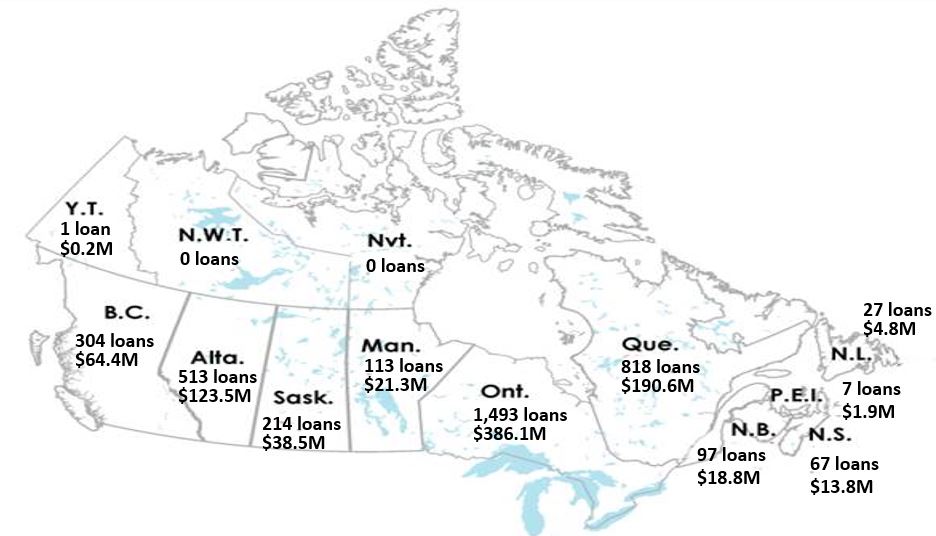Overview
The Canada Small Business Financing Program (CSBFP) is a loan loss-sharing program that partners with private sector lenders to increase the availability of financing to small businesses. Under the program, small businesses can access loans up to $1 million to purchase or improve real property, leasehold improvements and equipment. To be eligible, borrowers must have annual revenues of $10 million or less. The CSBFP is a national program that operates through a network of financial institutions in all provinces and territories.
The role of federal government
Innovation, Science and Economic Development (ISED) Canada is responsible for the design and administration of the CSBFP. It reviews and evaluates the legislative and regulatory frameworks and recommends improvements on a periodic basis. It also administers the program by registering loans, collecting fees and paying lenders eligible portions of losses on defaulted loans. ISED, however, is not involved in the disbursement and administration of the loans.
The role of lenders
Private sector lenders are responsible for making all credit decisions, approving and disbursing the loans, registering the loans with the CSBFP and administering the loans. Each lender has its own lending criteria subject to the requirements of the CSBFP. Once the loan is approved, the borrower receives the funds from the lender, not the government. If a loan is in default, the lender must recover all assets taken as collateral, before submitting the claim for loss to the CSBFP. Once the lender's information is reviewed and the claim is approved, the lender is paid 85 percent of the net eligible loss.
Highlights
Lending decreased significantly due to the COVID-19 pandemic
- 3,655 loans were made to Canadian small businesses valued at $864 million;
- Compared to the previous year, the number of loans decreased by 2,091 loans (36.4 percent), and the value of loans decreased by $436.2 million (33.6 percent);
- The average loan size was $236,374 which represents an increase of 4.3 percent from 2019–20.
- Fee revenues were $66.4 million, which represents a decrease of $7.8 million (10.5 percent) relative to the previous year.
Claims increased significantly due to the COVID-19 pandemic
The CSBFP paid a total of 872 claims to lenders representing $85.6 million. These claims were associated to defaulted loans made during the previous 10 to 15 years;
- The number and value of claims paid increased by 26.2 percent and 59.8 percent respectively compared to the previous year;
- The average claim size was $98,185, which represents an increase of 26.6 percent relative to 2019-20.
Start-ups and new businesses received the largest share of financing
- Start-ups and businesses operating less than one year continued to receive the majority of loans, which accounted for $538.8 million (62.4 percent).
Leasehold improvements and real property were the most common assets financed
- Leasehold improvements and real property loans represented $386.7 million (44.8 percent) and $251.1 million (29.1 percent) respectively;
- Equipment loans accounted for the remainder at $226.1 million (26.2 percent).
Lending was accessible in every province and territory
Three provinces; Ontario, Quebec and Alberta represented the majority of overall CSBFP lending in 2020-21, accounting for 2,825 loans (77.3 percent) and $700.3 million (81.1 percent).
Figure 1 shows lending across all Canadian provinces and territories during 2020-21. The breakdown by regions from highest to lowest volumes is as follows:
- Ontario: 1,493 loans (40.8 percent) totaling $386.1 million (44.7 percent);
- Quebec: 818 loans (22.4 percent) totaling $190.6 million (22.1 percent);
- Western Canada: 1,144 loans (31.3 percent) totaling $247.7 million (28.7 percent); and
- Atlantic Canada: 199 loans (5.4 percent) totaling $39.4 million (4.5 percent).
Figure 1: Number & Value of CSBF Loans by Province and Territory, 2020-21

The most popular sectors were the accommodation and food services and retail trade
- Accommodation and food services continues to be the largest industry sector using the CSBFP at $325.7 million, representing 37.7 percent of the total value of loans made followed next by;
- Retail trade sector at $111.8 million, accounting for 12.9 percent of the total value of loans, followed by;
- Transportation and warehousing at 3.2 percent and Arts, entertainment and recreation at 1.9 percent.
CSBFP's website, telephone and emails were common channels for small business information
The CSBFP website continued to be one of ISED's most popular sites, with close to 454,000 visits, an 82% increase in visits relative to 2019-20. In addition, more than 1,253 telephone and 595 email inquiries were received from small businesses and lenders through the program's info line and website. Finally, the program's PDF pamphlet was accessed online 9,346 times.
For more information on the administration and financing activities of the CSBFP since 1999, visit the CSBFP website or the Government of Canada's Open data portal.
